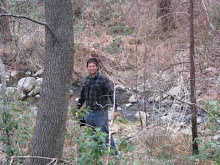
4 March 2009
William Heise County Park, San Diego County, California. 0945-1335. N33.0392° W116.5925°, Elevation 1265 meters. Casey Richart, Eric Tyler, Tommie Ebanez. Quercus litter and woody debris.
Overlooking the Anza-Borrego Desert State Park on S1 (all images by E. Tyler).
Eric Tyler, Tommie Ebanez and I met at 0700 in the SDSU A Lot. We took Interstate 8 east to S1 north. We stopped at the edge of a mountainous pine and oak forest. A platform extended out over a ravine and seemingly the entire Anza-Borrego State Park. It was about 42° F with steady 20+ mph winds out of the west; we stayed out of the car until we numbed to the cold, then climbed into the car and stayed into the car until we reached William Heise County Park. During the drive I was hoping to find a mature oak stand, but S1 straddles the crest of the Cuyamaca Mountain - with the oak forests down slope to the west and desert to the east. Wanting to find an oak forest is due in part to a bit of cryptozoology. I haven't queried local museums much, but from the limited amount of information I can glean from the literature it appears as if Anadenulus cockerelli hasn't been seen since 1945. That individual was collected in October and it is unlikely that such a poorly documented species will be found in a large annual window; I need to make sure I hit it hard next fall semester.


Eric Tyler, Casey Richart, and Tommie Ebanez at William Heise County Park
To get to William Heise County Park head south on Pine Hills Rd 1.0 miles west of Julian on SR 78, in 2.3 miles turn left onto Frisius Drive, then right onto Heise Park Rd 2.1 miles further. We arrived at 0945 and collected arthropods, birded, looked for Ensatina, and enjoyed the oak, pine, and cedar forest until 1335. Our route of travel from the visitor's parking was south on an authorized vehicles road passed the Kelly Ditch Trail to an area along Cedar Creek that likely has perrenial water; we returned north and then east along the Kelly Ditch Trail to the Cedar Trail which we followed north back to the car.
Collecting mostly focused on old Quercus bark, both bark on the ground surrounding decomposed trunks and peeled from standing snags. Tenebrionids and Carabids were commonly enountered; 3 distinct morpho-types of tenebrionids are pictured below.


Different types of tenebrionid beetles: bumpy, hairy, and fungus-loving. Samples of the hairy and bumpy are in the San Diego State University Research Collection.
The oak forest surrounding Cedar Creek south of Kelly Ditch Trail contained many large rocks and boulder, some Berberis and Symphoricarpus, but was dominated by poison oak. We hit it hard, digging through litter, flipping rocks and woody debris. Eric and I agreed that we'd be showing signs of a rash in about two days. I write now three days later without sign, but we still have time. Tommie originally took the news with some dread. This blossomed into euphoric anticipation of a new experience, he has never had the satisfaction of scratching the rash relentlessly like I like to do. I'm sure he's resigned to the fact that he's unlikely to come down with it now, though it might  make for a more memorable experience if he does. Nonetheless, our hard work payed off and we found the official March Forth! trip mascot, a young Ensatina eschscholtzii klauberi under some woody debris upslope in the forest.
make for a more memorable experience if he does. Nonetheless, our hard work payed off and we found the official March Forth! trip mascot, a young Ensatina eschscholtzii klauberi under some woody debris upslope in the forest.
 make for a more memorable experience if he does. Nonetheless, our hard work payed off and we found the official March Forth! trip mascot, a young Ensatina eschscholtzii klauberi under some woody debris upslope in the forest.
make for a more memorable experience if he does. Nonetheless, our hard work payed off and we found the official March Forth! trip mascot, a young Ensatina eschscholtzii klauberi under some woody debris upslope in the forest.Ensatina eschscholtzii klauberi
Other encountered included a Western Fence Lizard in a pile of oak bark. Spider diversity was impressive: we collected Megahexura, a type of Mecicobothriid; a couple of Gnaphosids that look to me like Herpyllus; a couple of Socalchemis Tengellids; some unidentified Angelinids, and perhaps my favorite, a cryptic and dorsolaterally compressed Thomisid Xysticus that was behind peeled oak bark. Examplars of all of these spiders are also in the SDSU Research Collection. Juvenile opilionid Protolophus were common but not collected. The milliped collection was productive; a couple species of Julida and a couple Chordeumatida including an adult male Striariidae which I must ship the Bill Shear soon. Both the chordeumatids were adult males. One of the julidans was collected under oak bark eating fungus. All millipeds will be shipped to William Shear at Hampden-Sydney College, Virginia. Eric also collected a Syrphid fly from near flowering Manzanita shrubs. Birds seen or heard are listed here: Mountain Chichadee, American Crow, Stellar's Jay, a Red-tailed Hawk flew over with a very full crop, Anna's Hummingbirds, singing Dark-eyed Juncos House Finch, Common Ravens, Acorn Woodpecker, Tommie's lifer Red-naped Sapsucker, Northern Flicker, Oak Titmouse, Scrub Jay, singing Spotted Towhees and Wrentits, and Mourning Doves, Turkey Vulture.
March Forth is not only about getting outside and going for a hike, but importantly it's about seizing the day for yourself. When a vulture flew over I introduced enskyment to my companions. And when we left the county park we headed to Mom's. I ordered a strawberry rhubarb pie with vanilla and a hot chocolate. Eric got an every-berry pie and Tommie some slice served with cinnamon ice cream. It was very very good; I need to return soon and often.







